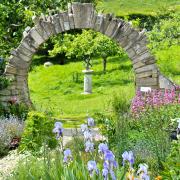Discover the great outdoors throughout the year with our selection of nature reserves located across Dorset.

Hartland Moor Nature Reserve
Hartland Moor forms part of the unique landscape of the Dorset Area of Outstanding Natural Beauty (AONB). The reserve is adjacent to Stoborough Heath National Nature Reserve and is managed as one contiguous unit.
The only way to really experience this unique habitat is to see it in all its moods; from the height of summer when it is at its most colourful, carpeted with pink and purple heather, to the frosty winter mornings when all the spiders’ webs sit frozen on the gorse.
Walk its sheer openness, taking in the stunning views of the surrounding countryside, including Poole Harbour and the ruins of Corfe Castle; follow part of an old mineral tramway that takes you across the moor, past grazing cattle and hardy ponies, and watch for rare wildlife like visiting hen harriers.
A visit to Hartland Moor can be special at any time of the year as every day is different in this extraordinary place, but to see the outstanding array of wildflowers and bird migrants, come for a visit between May and August.

Hartland Moor is a site of national and European importance for its lowland heathland which supports insects, reptiles and birds that are rarely found elsewhere and supports many specialised plants and animals.
Typical plants found on site are ling, cross-leaved heath, bell heather, bog asphodel, white beak sedge, western gorse, and rarities such as Dorset heath, marsh gentian and bog orchid. Heathland insects include rare heath and large marsh grasshoppers, and the site supports birds such as Dartford warbler, hobby, meadow pipit, stonechat, nightjar and hen-harrier.
Stoborough Heath Nature Reserve
Stoborough Heath forms part of the unique landscape of the Dorset Area of Outstanding Natural Beauty (AONB). The reserve is adjacent to Hartland Moor National Nature Reserve and is managed as one contiguous unit.
Catch a glimpse of dragonflies darting across the wet heath, look out for hardy ponies grazing, explore trails that follow part of an old mineral tramway and enjoy the fantastic views of the surrounding countryside, including Poole Harbour and the ruins of Corfe Castle.

The unique landscape of Stoborough Heath National Nature Reserve is part of our cultural and social history as well as our wildlife heritage. The Reserve has something to offer at any time of the year its stunning views and landscape, but to see the outstanding array of wildflowers and bird migrants, come for a visit between May and August.
Stoborough Heath is a site of national and European importance for its lowland heathland which supports insects, reptiles and birds that are rarely found elsewhere and supports many specialised plants and animals.
There are a number of walks and trails across the reserve. Disabled visitors can access part of the reserve via the way marked ‘Tramway Walk’, a level and accessible 500m track that follows the path of a disused mineral tramway. The track can be accessed from Sunnyside Farm where free car parking is available.
Sandford Heath Nature Reserve
Two hundred years ago, the Dorset Heaths covered over 150 square miles in vast tracts divided only by river valleys. Today only around 30 square miles remain, much of it in small fragments. These sites now represent around 10% of Britain’s heathland, and 2% of all that remains in Europe as a whole. Together with our partners, Natural England is reconnecting some of these isolated fragments.

If you enter the site from the western access near Sandford, you’ll find an area of woodland that includes beech, alder and birch. This gradually changes to mature Scots pine, before you emerge from the trees onto the open heath.
When the Reserve was bought by Natural England, conifers had already spread over much of the heathland. Many of these trees have now been removed and heather has been quick to re-colonise the land, growing back vigorously from dormant seed in the soil.
The eastern part of the site was once part of the Royal Naval Cordite Factory, which produced explosives during the Second World War. An imposing gun tower can still be seen; one of a ring of anti-aircraft defences that once protected the factory.
Valley of Stones Nature Reserve
The Valley of Stones is considered to have one of the finest examples of a Sarsen stone boulder train in Great Britain. Freeze/thaw conditions at end of the last ice age caused sandstone on top of nearby chalk hilltops to fragment and slump downhill. There is evidence that the site was used as an ancient ‘quarry’ with stones being taken from the area for use at other local megalithic sites.
The stones are set within a wider landscape of dry valleys and slopes of upper chalk that include extensive areas of fine calcareous grassland that is rich in butterflies and wild flowers. Within the reserve, well preserved medieval field patterns can be seen on some of the steep sides of the dry valleys and slopes of upper chalk.
The southernmost dry chalk valley contains an excellent example of a Sarsen blockstream or ‘valley train’ which also help support a rich lichen and bryophyte flora.
The surrounding areas of calcareous grassland support many species of butterfly and wild flowers including clustered bellflower and autumn gentian. Colonies of the iridescent adonis blue butterfly can be found on the steep south facing grassland slopes in association with horseshoe vetch, the larval foodplant of this spectacular butterfly.





























